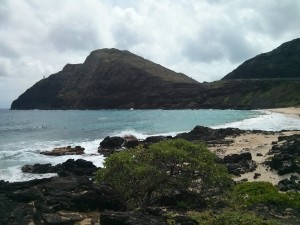 As we are flying over the beautiful mountains of B.C., I realize that my week-long Hawai’ian journey comes to a close. Despite this, I am certain this is only the beginning of my own venture into language revitalization and documentation.
As we are flying over the beautiful mountains of B.C., I realize that my week-long Hawai’ian journey comes to a close. Despite this, I am certain this is only the beginning of my own venture into language revitalization and documentation.
Thinking back on the past week, it is very difficult to pick any one part that stands out; every day was teeming with new friends, experiences and linguistic discovery. Hawai’ian landscape and beauty aside (an example photo below…), here’s a slice of my (Yuliya’s) personal highlights, which I will relay across several blog posts.
The theme of this ICLDC, “Enriching Theory, Practice & Application” was incredibly fitting for the wide-ranging crowd (e.g. I met people in library sciences, independent studies, and social policy). I guess the thing that hit home the most was the acceptance of different fields as lenses through which we can create an interdisciplinary approach to language documentation. The main question being, how can we connect and strengthen our individual practices with theory, and apply it to what communities need and want?
I particularly enjoyed the opening plenary talk for addressing this issue in a way that was accessible to linguists and non-linguists alike.
Lenore Grenoble (University of Chicago) has been working with the Arctic Indigenous Languages Project to help “assess, monitor and promote the vitality of numerous indigenous languages found in the Arctic” (taken from the project website). The project, led by many community members across the Arctic Circle (including members from Canada, Russia, Denmark, Sweden, Finland, Iceland, US, Norway), focuses on: 1. language policy; 2. language vitality assessment; and 3. language acquisition
Her talk addressed the following question: “How can a hitchhiker linguist help support language vitality?”
- Hitchhikers = linguists who are not permanent members of communities but rather visitors along for the ride
- As it turns out, language documentation can be fruitfully informed & even reoriented by guidelines created to teach communicative competence & proficiency in majority languages (i.e. taking a majority language proficiency test and making it suitable for smaller minority language communities)
- communicative competence = cultural knowledge and knowledge of social conventions
- Importantly, proficiency guidelines can be and should be informed by research in language acquisition, psycholinguistics and education
- Moreover, the guidelines should be task-oriented and culturally as well as socially situated
- That includes knowing how to speak, including knowledge of turn-taking mechanisms, appropriateness of nonverbal behavior, etc. (Savignon 2002)
- We should adopt a more action-oriented approach: language users are social agents who develop general particular communicative competences while trying to achieve their everyday goals
- This point is often overlooked or cut out by linguists who look at grammar; for instance, we tend to strip facial expressions in elicitations or when documenting natural speech
- (Here Grenoble emphasized, IT’S OK NOT TO LIKE THESE GUIDELINES AS LINGUISTS…BUT THEY ARE GOOD. This is what people WANT to know. This is what speakers in communities want to learn!)
- Language practices, too, can be revised. This is a large category that encompasses all the different ways we use language, e.g.:
- everyday idiomatic uses of language
- language games
- songs
- conversation, how to use language
- traditional: prayers, traditional speeches
- Thus, in documenting with your community, you need to ask yourself, “What skills are we trying to foster? What is realistic in language acquisition? What do learners want to know?” Paralinguistic meaning may be a big part of this.
- As an example, Grenoble presented some of her own research with Wolof, which is not endangered, but provides good evidence of shift in linguistic practices
- Wolof has clicks that are contrastive. They have not been documented as part of the morphosyntactic or phonological system but they are definitely there!
- Crucially, you can’t be a fluent speaker of Wolof without understanding/using these clicks!
- As a fluent speaker, you have to know how to say yes with a click, how to say no with a click, how to correct someone with a click, etc.
Stay tuned for Parts 2 and 3.

